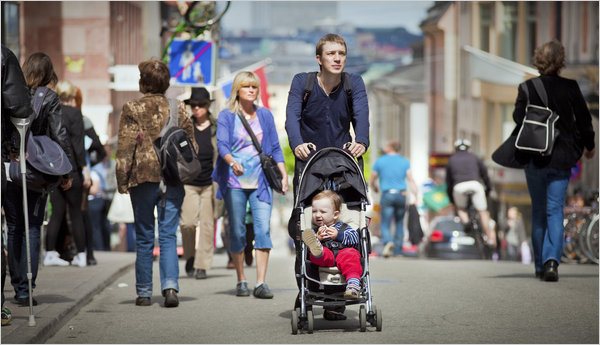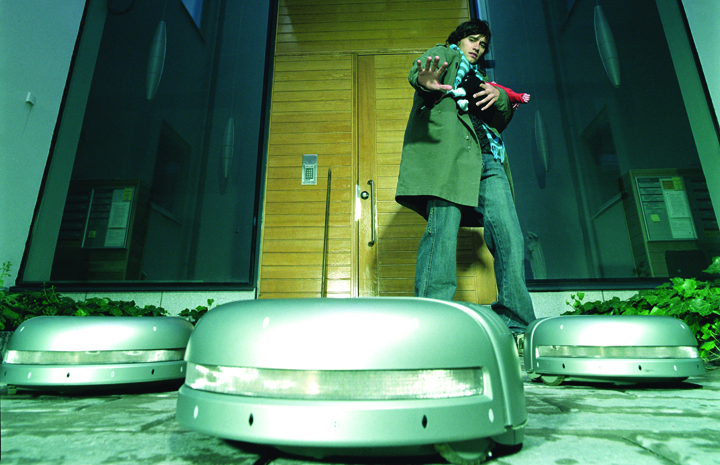Swedish Men according to NYT
The New York Times takes a close look at Swedish men—Sweden is portrayed as a rather unusual country when it comes to gender roles and family politics.
-
 Swedish men help take care of their offspring in ways most other men do not. An article from New York Times takes a closer look at the Swedish model.
Swedish men help take care of their offspring in ways most other men do not. An article from New York Times takes a closer look at the Swedish model. -
-
The NY Times just published an article on Swedish men that caught our attention: Sweden is portrayed as a rather unusual country when it comes to gender roles and family politics. In Sweden more fathers stay home with their children during the first year than in most other countries. This also mirrors a new identity for men in Sweden. “Men can have it all – a successful career and being a responsible daddy,” says Birgitta Ohlsson, European affairs minister. “Machos with dinosaur values don’t make the top-10 lists of attractive men in women’s magazines anymore.” Ohlsson, who has lobbied European Union governments to pay more attention to fathers, is eight months pregnant, and her husband, a law professor, will take the leave when their child is born. The article brings us back to 1974, when Sweden became the first country to replace maternity leave with parental leave, and the dads who then took it (they weren’t many back then) were quickly dubbed “velvet dads”. Bengt Westerberg, a Swedish politician and former leader of the Liberal People’s Party, says: “Society is a mirror of the family. The only way to achieve equality in society is to achieve equality in the home. Getting fathers to share the parental leave is an essential part of that.” According to the article, introducing “daddy leave” in 1995 had an immediate impact. No father was forced to stay home, but the family lost one month of subsidies if he did not. Soon more than 8 in 10 men took leave. The addition of a second nontransferable father month in 2002 only marginally increased the number of men taking leave, but it more than doubled the amount of time they take.
-
 As evidence by this photo for Nordic Reach Magazine by Mikael Ericsson Swedish men don't just help out with the children, they clean...
As evidence by this photo for Nordic Reach Magazine by Mikael Ericsson Swedish men don't just help out with the children, they clean... -
-
390 days in total
Parents may use their 390 days of paid leave however they want up to the child’s eighth birthday — monthly, weekly, daily and even hourly — a schedule that leaves particularly small, private employers scrambling to adapt. The Swedish model is one that other countries have looked at to imitate: Portugal is the only country where paternity leave is mandatory (but only for a week), Iceland has gone furthest, reserving three months for father, three for mother and allowing the parents to share another three months. But even bigger countries follow suit, Germany tweaked Sweden’s model slightly, reserving two out of 14 months of paid leave for fathers. Within two years, fathers taking parental leave surged from 3$ to more than 20%. Parental leave expert Professor Kimberly Morgan at George Washington University says to the NY Times: “That was a marker of pretty significant change. If Germany can do it, most countries can.” In Södermalm, Stockholm’s trendy south island, the days of fathers taking only two months are clearly over. Men with strollers walk in the park, chat in cafes, stock up at the supermarket or weigh their babies at walk-in daycare centers. Claes Boklund, a 35-year-old Web designer taking 10 months off with 19-month-old Harry, admits he was scared at first: the baby, the cooking, the cleaning, the sleepless nights. Six months into his leave, he says, he is confident around Harry. “It’s both harder and easier than you think,” he said. For many companies, a family-friendly work pattern has simply become a new way of attracting talent. “Graduates used to look for big paychecks. Now they want work-life balance,” said Göran Henriksson, head of human resources at the cellphone giant Ericsson in Sweden, where last year 28 percent of female employees took leave, and 24%t of male staff did. “We have to adapt.”
Read the entire article:
http://www.nytimes.com/2010/06/10/world/europe/10iht-sweden.html?pagewanted=1 -
 .. and cook too. Photo for Nordic Reach Magazine by Mikael Ericsson.
.. and cook too. Photo for Nordic Reach Magazine by Mikael Ericsson. -
See also the feature we did a few years ago in Nordic Reach, called 'The Nordic man' - http://www.nordicreach.com/its_about/lifestyle/160/
-
-
